As a necessary component of business today, packaging provides protection for products, as well as marketing value, but excess packaging remains one of the biggest wastes for today's companies.
Not only does excess, wasteful packaging cost more to produce, it also wastes the planet's resources. Additionally, excess packaging may even cause consumers to become annoyed or get angry when they must tear through layer upon layer of excess wrapping. Plus, more and more customers want the companies they purchase from to be environmentally sustainable.
A poll by the Canadian Broadcasting Corporation (CBC) recently found that consumers believe extra packaging is frustrating and dangerous. In fact, CBC gave a name to the feeling a consumer has when dealing with too much packaging: "wrap rage."
According to the CBC's article:
More than 90 per cent of Canadians who took part in the Marketplace poll say they have experienced rage when opening a product in the past five years, while 69 percent say they have injured themselves in the process.
Sustainable packaging that doesn't use excess materials and employs sustainable manufacturing techniques will not only reduce costs associated with packaging, but it will reduce a company's carbon footprint, and even improve a customer's experience with your company's products. Some companies have even managed to become 'zero waste' businesses!
Here are ten stellar and unique examples of green, sustainable packaging:
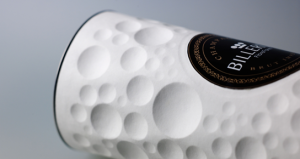 1. Fibreform® Biodegradable Packaging
1. Fibreform® Biodegradable Packaging
One of the reasons for the use of plastic and heavy packaging today is for preservation and protection of consumable products and items that might otherwise spoil without appropriate protection.
An innovative product from Swedish firm BillerudKorsnäs called FibreForm® not only protects food from things like moisture and bacteria, it also features sustainable construction. The material is strong enough to be molded into just about any shape, which opens the door to packaging creativity for foods that must be protected during transit or while they sit on a store shelf.
According to the Environmental Protection Agency (EPA), food and the containers used to house food make up around 45 percent of the trash dumped into landfills each year.
Between 4 and 10 percent of food purchased by food service operations in the U.S. is thrown out before reaching the plate. By reducing the amount of food and packaging discarded, they can significantly reduce their waste stream and save money.
Biodegradable packaging like Fibreform® offers a solution for businesses looking to reduce overall packaging, as well as use a biodegradable method of packaging.
 2. TerraSkin® Paper Made from Stone
2. TerraSkin® Paper Made from Stone
Many sustainable packaging designs come from recycled paper, cardboard, and plastic, but the TerraSkin® line of gift boxes ventures into unique territory.
The boxes and shopping bags used at the Museum of Modern Art in New York are made out of crushed stone, even though they resemble regular paper.
According to the company, there are many reasons to go "tree free," and reduce use of wood pulp:
Although about 30% of the world's wood pulp supply now comes from tree farms, by and large forest-harvested timber still dominates supply. In truth, even if artificial tree plantations have taken some pressure off deforestation, tree farms host about 90% fewer animal species than the natural forests that preceded them.
An article in "Bloomberg Businessweek" suggests one of the only weak spots of this ingenious method of creating packaging is that it's more expensive than traditional paper.
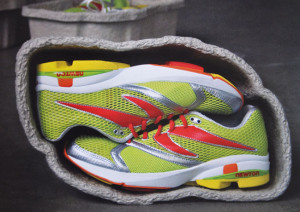 3. Newton Running's Eco-Friendly Shoe Box
3. Newton Running's Eco-Friendly Shoe Box
When you open a pair of Nike or Adidas shoes, you'll usually see a large, rectangular cardboard box inside which a pair of shoes sits wrapped inside more paper. The companies stuff even more paper inside the shoes to help them retain their shape during transit.
In 2009, running shoe company Newton Running hired designers to create a molded carton constructed of 100% post-consumer recycled material to house its shoes.
The athletic company eliminated the need for extra packaging by creating a stiff exterior for its shoe housing. To ensure the shoes wouldn't get crushed during transit, the company gave buyers reusable shoe bags and socks stuffed into each shoe.
According to Newton Running's official blog on the wasteful nature of standard shoe boxes:
We learned that not only were the pulp boxes significantly more expensive to make, but they are produced far from the footwear factory and they would dramatically increase overall freight costs because they do not stack in containers, warehouses or retail stores efficiently.
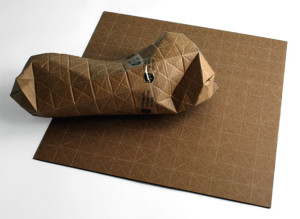 4. The UPACKS "Universal Packaging System"
4. The UPACKS "Universal Packaging System"
Ever get something in the mail that's a package that sits in another, larger package? Excess packaging costs more to ship and is an outright waste of the planet's resources.
Green-friendly companies have long extolled the virtues of the "less is more" approach to packaging.
One innovative designer came up with a corrugated cardboard box system that would fold into compact shapes around parcels while retaining structural integrity and reducing the overall packaging required to ship an item.
According to designer Patrick Sung, creator of the UPACKS system:
The patterns make it easy to fold and conform to almost any shape while maintaining structural rigidity and protecting the contents.
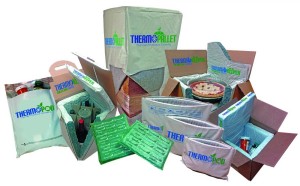 5. ThermoPod Biodegradable Mail-Order Shippers
5. ThermoPod Biodegradable Mail-Order Shippers
Shipping perishables like food, pharmaceuticals, and cosmetics often requires special packaging that's thick, heavy, and stressful on the environment. Not only does packaging usually require an outer shell, but keeping items like chocolate, seafood, and medication cool requires further packaging around the interior of the box.
A protective packaging called ThermoKeeper is designed to reduce the non-biodegradable waste that ends up in landfills by providing packaging that keeps shipments protected and features material that will biodegrade in just one year if it ends up in a landfill.
According to an article on Refrigerated Transporter on the insulation material:
The insulating cotton padding is produced using a selected blend of recycled cotton fibers that are super-absorbent for containment of spills. It includes a time-sensitive, US Environmental Protection Agency-approved antimicrobial additive for cross-contamination prevention.
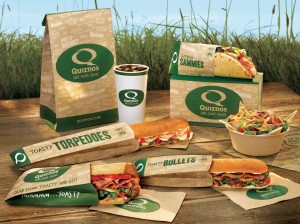 6. Quiznos Take-Out Containers
6. Quiznos Take-Out Containers
The CEO of sub sandwich restaurant Quiznos says that he was inspired to reduce the waste created by his company after he watched the Disney/Pixar film "Wall-E," in which a robot was tasked with cleaning up an Earth of the future that was filled with garbage.
A report from "QSR Magazine" on the company's green-friendly efforts reveals that the company isn't just content to offer customers green, recyclable packaging.
We're looking into what we can do to negotiate with municipalities and other governments to find out if we can introduce more recycling…if we can try to get more of our waste taken to composting facilities, if we can get our waste taken to sorting facilities.
In addition to green packaging and bigger recycling efforts, another article on Trend Hunter suggests that the company was even set to give its employees uniforms made of recycled plastic bottles.
 7. Barely-There Packaging by Früute
7. Barely-There Packaging by Früute
Ever tear into a box of cookies and have to make your way through an exterior box, a plastic inner-liner, and then see cookies held in place by yet another plastic tray?
A gourmet cookie company operating out of Los Angeles named Früute recently did away with most of the packaging surrounding their delicious treats, which allowed the cookies and desserts to take center stage rather than become hidden within a maze of packaging.
According to an article from Trend Hunter on the design company that helped conceive the barely-there packaging:
Ferroconcrete's tactic is an honest one, leaving as little material as possible between the biscuit and the buyer, with just enough to protect the goods and not quite enough to hide their enticing textures and flavor-rich colors.
 8. Puma's Clever Little Bag
8. Puma's Clever Little Bag
In 2011, athletic company PUMA worked with design company fuseproject to create a new shoebox for its shoes that featured a flat piece of cardboard that eliminated the extra packaging and paper normally used to protect the shoes within the box.
To protect the structure of the shoes while in transit, the box featured cutouts that could be removed from the box and inserted into the shoes. The cut-outs eliminated the need for extra packaging.
The design won The Dieline Awards "Best of Show" award in 2011, and of the packaging Dieline said:
Not only is the design functional and environmentally-friendly, the "Clever Little Bag" is an iconic brand element upon leaving the store as it replaces the plastic shopping bag.
 9. Ecovative's® Mushroom Packaging
9. Ecovative's® Mushroom Packaging
Finding renewable and natural materials for sustainable packaging is one of the biggest challenges for companies today, and mushroom packaging from Ecovative Design truly hits the nail on the head as far as renewable packaging and reduced energy costs are concerned.
Not only is the packaging made out of actual mushrooms, which are a natural and renewable resource – and fire-resistant, too – but it costs just one-eighth of the energy required to produce foam packaging.
According to the company's official website:
Mushroom Packaging has won the highest awards and is in use right now around the world by a number of Fortune 500s and other customers committed to more sustainable packaging.
Additionally, since mushrooms grow just about anywhere, manufacturers could reduce the transportation costs associated with getting the packaging to its destinations through locally grown mushrooms.
 10. The 360 Paper Water Bottle
10. The 360 Paper Water Bottle
According to statistics cited by "The Huffington Post," humans use 50 billion water bottles every single year, with around 30 billion of those bottles coming from the United States.
To put those figures in perspective, the United States contains less than 5 percent of the world's population, but uses around 60 percent of the world's supply of plastic bottles.
To combat this shocking waste of the planet's resources, an inventor and designer from New York named Jim Warner created the 360 Bottle. In an interview with "gizmag," Warner said:
Here in the US 60 million plastic bottles are thrown out each year…Only 14 percent are recycled. I wanted to create something that challenged the "norms" and was sustainable, elegant and practical.
The water bottle is made from sustainable materials like bamboo and palm leaves, and even boasts a tear-off top that also re-attaches to seal the bottle again. The design won the INNOVIC International Next Big Thing Award for 2009 in the international category.
Want to Use Green Sustainable Packaging?
These are some great examples of sustainable packaging in action. If you'd like to put a plan in action for your own business, here are a few ways to do it. How do you tell if your business is green? Here are a few traits to emulate.
Market your company's brand through creative, sustainable packaging options from Howard Packaging. If your business is interested in using modern packaging solutions, let us know! Find out what we can do for your business. Request a Free Catalog and Sample Kit Today!
